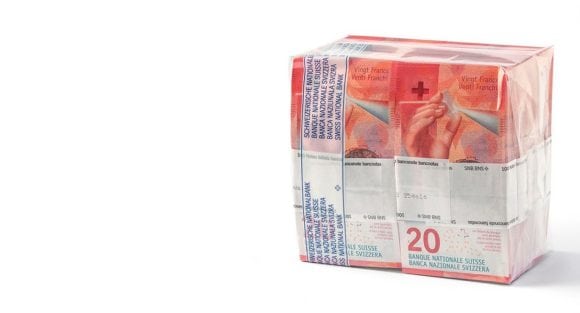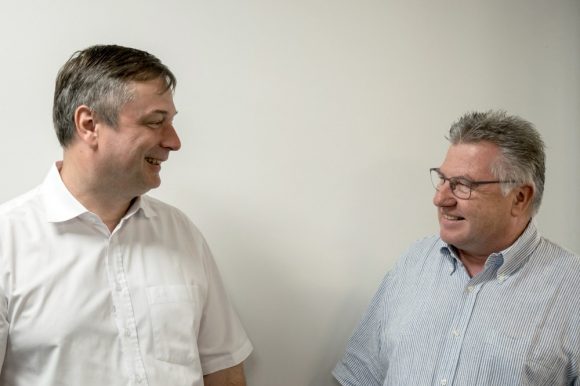We’re here for you
Arrange an appointment for a non-binding consultation or if you have any questions, just give us a call.
New banknote series
The National Bank will launch the new 10-franc note on October 18. Jürg Richter and Ruedi Kunzmann reveal what makes it special.

Kunzmann: Top marks. And I’m not the only one to think so. The International Bank Note Society gave the new Swiss 50-franc note its “Banknote of the Year Award” for 2016.
Kunzmann: The notes are vertical in format, just like the previous banknote series. It’s not very common elsewhere. Banknotes are usually horizontal. What’s more, our new banknotes are fresh, vibrant and hip. They reflect Switzerland as it is today.
Richter: On the contrary: The design is now more compact. It sometimes lost its impact on the old banknotes. Bigger isn’t better.
Richter: That’s only true of our banknotes. They act as a kind of calling card for Switzerland. People’s first contact with a country often comes through its currency. The bright color of our notes reflects our diversity and dynamism. The US dollar and the euro seem dull and boring in comparison.
Richter: Absolutely. The National Bank cites 15 security features on its website – ranging from the tilt effect to the Swiss cross made of small perforations that can be seen when held up to the light. Anyone can check these features. It’s less well known that the National Bank also incorporates additional, strictly confidential security features into the notes. These would only be referred to in the case of a large-scale forgery attempt.
Kunzmann: Theoretically, yes. Genuine banknotes have their own distinctive smell, ink that rubs off onto white paper and sound different when scrunched up. However, you’d be surprised at the number of people who don’t even know which color each note has. They’re poor observers. That’s why the security features are aimed at the professionals and authorities – and not the general public.
Kunzmann: There haven’t been any serious attempts to forge either the last banknote series or the new one. The last cases of counterfeiting were some time ago now. In 1976, Hans Jörg Mühlematter succeeded in printing an almost perfect 100-franc note. But he was caught and sent to jail just a few weeks after putting fake banknotes worth CHF 6 million into circulation. Two decades later he tried again, this time with 1000-franc notes. Once again, Mühlematter ended up behind bars. But at least he made sure that the mafia wouldn’t be able to pay him using counterfeit money: he drew a tiny smiley in the antennae of the pictured ants. These forgeries were highly coveted by collectors – but the law saw to it that all of the recovered notes were shredded.
Richter: Unlike online currencies such as bitcoin, banknotes are backed by a country’s economy activity, i.e. its gross national product. A banknote represents a promise to pay the bearer. It is as trustworthy as the state issuing it. In Switzerland, we’re in a very good position: our Swiss National Bank turns a profit each year. We take top spot in the international rankings. In addition, we have very low inflation here.
Kunzmann: The old banknotes used to say: “Payable in gold or silver.” To engender trust, banknotes had to be backed with something of substance. Here’s an example: thieves once broke into the former Farnsburg Brewery in Gelterkinden. They only took the coins and left the more valuable banknotes lying. That shows the widespread distrust of paper money that used to exist.
Richter: Yes. What can be described as a banknote made of rice fibers and dated 1388 was found in China – alongside indications that even older specimens may exist. These were used to record how many copper “cash” coins had been deposited. Cash coins are easily recognizable by the hole in their middle. They were produced in China for centuries.
Kunzmann: Sweden introduced banknotes in the 17th century. However, these were really bills of exchange. The promise to pay only applied to those who had deposited coins or gold bars as collateral.
Richter: These notes are so rare that each and every one of them is very special. If you owned a piece of paper like that back then, you got noticed. Don’t forget – 150 years ago, 100 francs was equivalent to several months’ salary. That’s why people didn’t want to hold onto paper money for long. They exchanged it for coins as quickly as possible. Until 1967, all coins – from 50 centimes to 5 francs – were made of silver.
Kunzmann: Somewhere between 5,000 and 50,000 francs. There may have been up to 400 to 500 different banknotes issued on Swiss territory, of which only 5 to 10 percent can still be traced. Many are rarities, occasionally to be found in museums or private collections.
Richter: The one designed by Lucerne-based artist Hans Erni during the Second World War. Unfortunately, it was never issued. Because Erni was accused of being a communist, the National Bank kept the series in reserve.
Kunzmann: Until the next-to-last series, the National Bank always designed a series of reserve banknotes that it could launch in an emergency. These include the banknotes by artist Roger Pfund, who also designed a series of French banknotes.
Richter: That’s been true since Singapore’s 5000-dollar bill went down in value. However, the US 10,000-dollar note of 1929 is still legal tender – as is the US 100,000-dollar bill of the 1930s. It was meant to facilitate payments between banks, including central banks. There was no such thing as electronic transfers back then.
Kunzmann: According to the National Bank, this banknote is to highlight Switzerland’s talent for organization. Time is the main element. Yet there is still a long way to go in turning Manuela Pfrunder’s graphic design into a finished banknote. All the security features have to be incorporated, including a plastic component. That means a lot of hard work for the artists. Let’s just wait and see!
Kunzmann: Sadly, the new series of notes looks set to be the last. In Sweden, cash is more or less disappearing. Even church donations are now collected electronically.
Richter: States are interested in having total control over tax revenues. That’s why they are pushing for cashless transactions. But, in doing so, they are overlooking many problems. There is likely to be an explosion in data-related crime, for instance. And an electronic crash would cause the whole economy to collapse. Cash has a long history and still has many advantages to recommend it.
Richter and Kunzmann in unison: But of course!

Jürg Richter (left) is the managing director of SINCONA AG and an auctioneer. He has over 30 years of experience as a numismatist. Before founding SINCONA, he was head of the Numismatics department at UBS. His areas of expertise include modern gold and silver coins from the 17th century onwards, Swiss cantonal and federal coins, pattern coins, shooting medals and banknotes.
Dr. Ruedi Kunzmann, originally a vet, has been involved in numismatics for more than 50 years and has been following local auction events for just as long. His areas of expertise include Swiss cantonal coins, banknotes from all over the world as well as counterfeit foreign currency.
Richter and Kunzmann have written several books on numismatics, including the standard reference work on Swiss banknotes.
The new 10-franc note is due for release on 18 October 2017. The remaining notes in the National Bank’s 9th series will be issued gradually between now and 2019. Last year, an average of 425.9 million banknotes worth CHF 72.2 billion were in circulation. This high figure is due to the fact that, according to the National Bank, demand for hard cash has increased again since the financial crisis.
Arrange an appointment for a non-binding consultation or if you have any questions, just give us a call.
